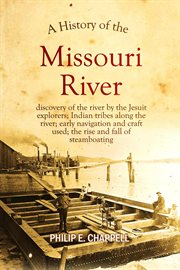Nonfiction
eBook
Details
PUBLISHED
Made available through hoopla
DESCRIPTION
1 online resource
ISBN/ISSN
LANGUAGE
NOTES
What inside knowledge did 30-year steamboat pilot Chappell dish out about the Missouri River Steamer "Bedford" which sank with $100,000 in gold on board? In introducing his 1906 book "A history of the Missouri River," Chappell notes, "There is but little doubt that had the Missouri river been discovered before the Mississippi the name of the latter would have applied to both streams, and the Missouri would have been considered the main stream and the upper Mississippi the tributary. The Missouri is longer than the entire Mississippi, and more than twice as long as that part of the latter stream above their confluence." Author Philip E. Chappell was born on the bank of the Missouri river, near Jefferson City, and for more than 60 years lived in sight of the river. During his early life he was engaged in steamboating on the river; afterwards became a steamboat owner, and maintained his connection with the river as long as navigation continued. The Missouri River is formed in Southwestern Montana by the junction of three streams (the Three Forks)-the Jefferson, the Madison, and the Gallatin-which rise in the Rocky Mountains. After a long course east through Montana it bends to the southwest and crosses North and South Dakota. It serves as the boundary line between Nebraska and Kansas on the west, and Iowa and Missouri on the east, and finally crosses the last-named State to its function with the Mississippi-20 miles above St. Louis. Chappell's book covers the span of river history from Marquette in 1873 to the demise of steamboating shortly after the Montana goldrush had ended and the railroad reached Bismarck in 1872. The mouth of the river was first seen by Marquette and Joliet (1673), and it was partly explored by La Verendrye (1738). The headwaters were first explored, and the river fully mapped and surveyed, in 1896, by a government expedition. In the eighteenth century the Missouri was active in the fur trade; and in the first half of the nineteenth, from the introduction of steam vessels to the westward extension of the railroads, it saw its era of greatest prosperity
Mode of access: World Wide Web







